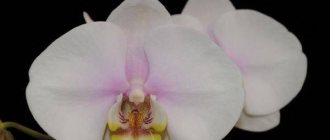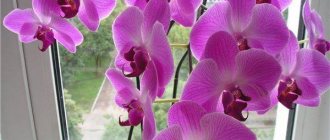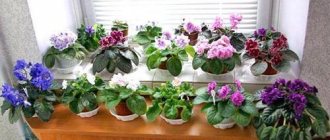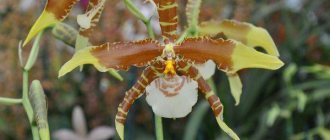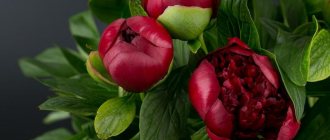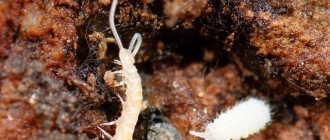Of the many hybrids available commercially, White phalaenopsis orchids are considered the most unpretentious and well adapted to home conditions.
They can easily withstand sharply changing climatic seasonal conditions in the house and have good resistance to many diseases.
In this article we will look at the names of species and varieties of white phalaenopsis, as well as give a brief description of them and describe the features of caring for them. Due to its characteristics, it is the white hybrid that has become the most popular in home growing of orchids.
Variety of varieties
Although white is one of the most popular colors among gardeners, pure white is extremely rare. Basically, it has some color splashes or a different colored edging.
It is believed that the “Amabilis” variety became the progenitor of many varieties and hybrids of this orchid variety. It is impossible to list all the hybrid varieties due to their diversity, but the most popular are:
- "Adelaide"
- "Alabaster";
- "Alaska"
- "Bristol"
- "Cotton Candy";
- "Anthyra Darwin";
- "Christa Wichmann";
- "Cristella"
- "Diamond"
- "Formosa Dream";
- "Gold Lip";
- "Island"
- "Japanese Heart"
- "Kiska"
- "Malibu Chablis";
- "Madonna"
- "Memories"
- "Misty Mountain"
- "Polar Bear"
- "Prima Piano"
- "Ragen"
- "Salt Lake"
- "Samoa"
- "Soft Cloud" etc.
They can have different flower sizes - from large (Royal) to small (mini Mark). The size of the plant itself is also varied, from mini to 1 m.
Names of species and varieties of white phalaenopsis and their photos
Royal
The Royal White Phalaenopsis Orchid is a species with very large flowers . Some specimens reach a diameter of 15 cm.
In principle, care differs little from classical care, but there are still nuances when growing. A more strict attitude towards temperature conditions (22-24 ° C). In autumn, it is better to place it in a room with a temperature of 14 ° for a couple of months, which will stimulate it for the next flowering.
Royal white phalaenopsis.
The pot must be transparent to ensure sufficient light supply to the roots and increase their photosynthesis. Be more responsible when it comes to watering, trying not to over-water or dry out the flower.
Royal Phalaenopsis requires higher indoor humidity . 70-80% would be optimal. Fertilizing also requires a slight increase in dosage. But the main thing here is not to overdo it.
Multiflora
The name Multiflora refers to a small orchid with a large number of buds. Although this name is given for commercial purposes, since such a name does not exist in the scientific literature.
It is distinguished by reduced watering, fertilizing, mainly liquid fertilizers special for orchids. Not so different from classic care, but requires more attention from the owner.
Multiflora variant with white flowers.
Wanda
A distinctive feature of Vanda is its caramel aroma and long flowering. The characteristic differences and features are considered to be a fairly dense stem structure and thick, hanging aerial roots.
Orchid Vanda Tanjanee White.
Peduncles grow from the axils of the leaves. Some aerial roots can grow up to 2 m. In addition, the plant is capable of producing up to 4 flower stalks with 15 flowers on each.
The content is practically no different from the usual for orchids. For a more stable position with such a number of peduncles and large roots, it is better to keep it in a glass pot with drainage holes.
Mini and midi
Mini is a small plant with small leaves, a small number of flowers and peduncles.
White mini phalaenopsis.
Midi - average between mini and standard orchid.
If the mini leaf is up to 9 cm , then the midi is about 15-16 cm , while the standard one is about 20 cm. And, of course, the flowers also differ in size.
Phalaenopsis midi (interior photo).
Butterfly
White butterfly is not a name. This is the common name for white phalaenopsis, whose flowers resemble species of moths or butterflies. Therefore, another concept of a white orchid is the White Butterfly.
White phalaenopsis butterfly.
White Heron
The white heron is called the Habenaria radiata . Its pearly white flower resembles a flying bird. It received this name in Japan, where it is in special demand.
Advice! When growing this type of orchid, you should thoroughly familiarize yourself with the conditions and care for growing it at home.
This type of orchid is quite capricious to care for. Does not tolerate drying out of roots and has a negative attitude towards insufficient lighting. Requires a completely different approach when growing.
White heron.
Landing
Orchids urgently need nutritious soil, and also actively take in the nutrients that are so necessary for flowering. On average, it is recommended to feed the plant after every third watering with special fertilizers “For orchids”.
Many beginners are interested in the question of which container to choose for planting a flower: plastic or clay. Experienced gardeners recommend giving preference to transparent plastic pots.
In clay plants, the root system often dies. In such pots, the rhizome does not absorb moisture well and sticks to the walls of the container.
Another advantage of plastic pots is that they are often equipped with excellent water drainage, special stands, and the root system is well ventilated. All this together creates ideal conditions for the growth and development of the orchid.
IMPORTANT! Transparent pots are also useful because much more light reaches the roots, which cannot be said about clay containers.
External characteristics of Phalaenopsis Amabilis
"Amabilis" is the progenitor of many hybrids growing in nature. It can be found in Borneo, Ambon, Australia, northern Philippines, New Guinea, Java and the Celebes Islands.
Mature plant height
The plant itself is a monopodial epiphyte, stem size from 10 cm to 50 cm , with 4-5 double-rowed, long, elliptical, fleshy leaves.
Phalaenopsis amabilis.
Maximum peduncle length
The flower stalks of an adult plant can reach a meter in length. Depending on the growing conditions, they have an average height of 60 to 90 cm.
It often produces a pair of fairly branched, arched, purple-colored flower stalks at once.
Flower diameter
Typically, 15 flowers develop simultaneously on a peduncle, but an adult plant can bear up to 70 fragrant flowers at the same time.
Their diameter on average ranges from 7 to 9 cm . There are specimens whose diameter can be up to 12-13 cm.
The wide petals and sepals look impressive, having a milky white color with a hint of pink on the outside.
Growing in nature
What we see on the shelves in flower shops and centers are artificially bred hybrids , the ancestors of which grow in areas of Southeast Asia in tropical forests saturated with high humidity. These are mainly South China and Indonesia.
This type of orchid received its name in the first quarter of the 19th century from the director of the Leiden Botanical Garden, Karl Blume, who, while on the Malay Archipelago, confused the snow-white phalaenopsis with a flock of white moths.
This is where the name of this amazing flower comes from - the butterfly flower.
Moisture-saturated, dark places with a constant temperature of about 19-27 ° C, which practically does not change seasonally, with nearby swamps, rivers, and streams are the most preferred place for phalaenopsis to grow in the wild.
Tenacious aerial roots entwine the branches and trunks of trees growing in this area. It is these roots that serve the plant as a source of moisture , which they absorb during periods of rain, frequent fog and high air humidity.
Also, the main food is plant residues formed after rotting in the bark of a tree.
Important! Phalaenopsis is an epiphytic plant - it grows on trees, stumps, snags and various ledges.
An orchid is not a parasite, i.e. does not harm the tree. The trunk and branches serve only as a support, making it possible, clinging to the roots, to rise towards the light in the darkened tropical forest.
Transfer
It so happened that orchids are replanted only when absolutely necessary , and the process itself most often consists only of moving the plant into a larger container. And this is true, because, as you know, any stress is detrimental to orchids.
The substrate for transplantation can be made with your own hands. For this you will need all the bark, charcoal, crushed granite. It is recommended to fill cracks and small holes with moss, preferably sphagnum, as it absorbs moisture well.
IMPORTANT! Florists recommend adding dry fern roots or fallen tree leaves to the substrate - you can forget about fertilizers. After transplantation, watering the orchid is prohibited for 5-7 days.
An interesting fact is that the Luna orchid can grow remarkably well in an aquarium, vase or any other large glass container.
This allows you to maintain a sufficient percentage of humidity in the air.
We must not forget that when moving a flower, you should be prepared for the fact that the plant will take a long time to get used to its new place of residence and, therefore, the next flowering may occur later than it should.
When the flowering period is over, only the owner can decide what to do next.
However, always remember that the orchid urgently needs care and attention , otherwise the pet will simply wither and die.
Features of care
Its unpretentiousness in conditions and care has made the white orchid one of the most popular flowers for home cultivation.
Optimal conditions of detention
The optimal conditions for growing white orchids are:
- diffused light;
- 14 hour daylight hours;
- maintaining the temperature at 22-24°C;
- maintaining humidity (at low humidity, daily irrigation with “rain mist”), avoiding moisture getting into the flower rosette;
- a clear plastic pot with sufficient drainage holes;
- no draft.
Example of a phalaenopsis pot.
Flowering time and dormant period at home
Flower growers should know that predominantly all varieties of white orchids are characterized by long flowering . They also have virtually no rest period. Of course, if conditions are created that are acceptable for her and proper care is provided.
The time of year does not affect the flowering time. Typically, white phalaenopsis blooms for about six months and, after a short break, begins to bloom again.
Watering and fertilizing
One of the important stages when growing any type of orchid is proper watering and timely dosed fertilizing.
Watering is carried out in two ways - watering can and immersion . During the flowering period, it is best to provide watering with a watering can, then the risk of damage to the buds is reduced.
The substrate is saturated with moisture by carefully watering along the edge of the pot once a week. During the dormant period or before flowers appear, use the immersion method, lowering the pot into a container of water for a couple of minutes.
Important! Water for irrigation should be settled, soft and not cold. The optimal water temperature for irrigation is +28 °C. Frequent watering is excluded.
For full development and flowering, additional feeding is necessary. It is produced several times a month with special complex fertilizers for orchids:
- in the summer and during the flowering period it is carried out 2-3 times a month, preferably with a reduced dosage;
- in the cool season, fertilizing is reduced to 1 time per month.
If there are no buds on the peduncle, then fertilizing is not carried out.
Stimulating flowering
An artificially created slight stress condition stimulates phalaenopsis to flower. To do this, the plant is removed to a room with a temperature of about +18 ° for 8-10 hours , and then returned to its usual place with a warm temperature.
You can also use special preparations that stimulate the orchid to form flower stalks. These include: “Bud”, “Plumen”, “Ovary”, etc.
Pruning after flowering
It is recommended to trim the peduncle of white phalaenopsis in two cases:
- If the peduncle is too long, which spoils its aesthetic appearance for the owner, its arrow is shortened;
- When it turns yellow. If this happens, it is cut off completely.
After purchasing in store
Caring for a flower after purchasing it in a store depends on the condition in which you purchased it:
- How does it stay in the pot?
- Is it sustainable?
- Is it blooming or when has it faded?
- Condition of the substrate, etc.
If the substrate is in good condition and the plants in it are sufficiently stable, then replanting is not required. An exception can be considered replacing a flower pot you don’t like.
For acclimatization, it is better to remove the flower for a while in a shaded and well-ventilated place. Usually 3-5 days are enough for the plant to acclimatize to new conditions.
It is worth feeding the orchid with complex fertilizers , reducing the proposed dosage by 2-3 times. Particular attention should be paid to the root system and provide it with proper watering: spilling - drying.
Fertilizing with complex fertilizer.
Attention! In case of a forced transplant, you should purchase a new substrate and create all the necessary conditions.
Prevention of diseases and pests
Experienced orchidists recommend that after purchasing a flower in a store, treat it with a fungicide to prevent diseases. Also carefully examine the root system and remove diseased parts, disinfect the substrate and pot.
When growing, strictly monitor watering, room humidity, temperature, light, etc., since deviation from the required conditions can lead to flower disease.
For preventive measures, timely, dosed fertilizing has proven itself well. They serve to enhance the plant's immune system.
Growing rules
In general, the plant develops well at home. Favorable conditions for active growth are the temperature, which should be at least 25 degrees and no more than 30. In winter, it is recommended to lower the temperature to 20 degrees.
IMPORTANT! Experts strongly recommend not placing pots of flowers outside or on the balcony, because there the temperature can drop to 10-13 degrees, which is detrimental to the orchid.
After temperature, the next most important aspect is lighting. And if in the summer, when daylight hours are as long as possible, there are no problems with sufficient lighting, then in winter it is necessary to create a small artificial additional lighting . This will ensure proper growth and abundant flowering.
In winter, orchids need lighting.
IMPORTANT! Make sure that direct sunlight does not burn the leaves. The pot must be placed on the east side.
If the plant does not like the chosen place, it will definitely let you know about it. The leaves begin to lighten - provide shade, the leaves become dark green - move the flower to a more sunny place.
The next stage in ensuring favorable conditions is moisture. The Luna orchid loves humidity, but watering should be moderate , and the substrate should never be flooded with water to prevent stagnation. Excessive amounts of water should be left for other plants.
To ensure the required level of humidity, experienced gardeners recommend purchasing a special mini-greenhouse or air humidifier. It is recommended to grow the flower at a humidity of 70%.
Phalaenopsis amabilis.
Changing color at home
A frequent, but still inexplicable from a scientific point of view, phenomenon in which the color of a flower changes. Possible reasons for this phenomenon are explained by the following possible factors:
- artificial coloring by sellers , which wears off over time, is washed off, or for some other reason comes off and returns to its natural color;
- insufficient lighting can provoke a change in brightness and color saturation, which creates a deviation in color;
- oversaturation of expensive complex fertilizers by sellers containing microelements that affect the intensity and richness of flowering. At home, the nutrition gradually loses its strength and the flower takes on its original appearance;
- changes in growing conditions : lighting, rearrangements, stressful moments, all this can affect color changes;
- the natural component is when, as the flower blooms, the color shade changes.
You never know how the bloom will turn out. Will the flowers be large or small, rich in color or dull? Environmental factors, conditions and care present surprises every time.
